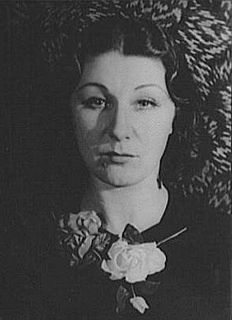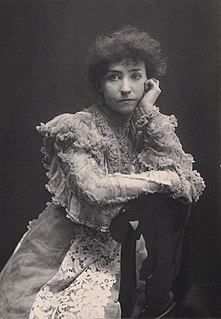
Dame Frances Margaret Anderson,, known professionally as Judith Anderson, was an Australian actress who had a successful career in stage, film and television. A pre-eminent stage actress in her era, she won two Emmy Awards and a Tony Award and was also nominated for a Grammy Award and an Academy Award. She is considered one of the 20th century's greatest classical stage actors.

Maude Ewing Adams Kiskadden, known professionally as Maude Adams, was an American actress who achieved her greatest success as the character Peter Pan, first playing the role in the 1905 Broadway production of Peter Pan; or, The Boy Who Wouldn't Grow Up. Adams's personality appealed to a large audience and helped her become the most successful and highest-paid performer of her day, with a yearly income of more than one million dollars during her peak.

Edward Brewster (Ned) Sheldon was an American dramatist. His plays include Salvation Nell (1908) and Romance (1913), which was made into a motion picture with Greta Garbo.

Bertha Kalich was a Ukrainian-Jewish-American actress. Though she was well-established as an entertainer in Eastern Europe, she is best remembered as one of the several "larger-than-life" figures that dominated New York stages during the "Golden Age" of American Yiddish Theatre during the late nineteenth and early twentieth century. Historians estimate that, during her career, Kalich performed more than 125 different roles in seven different languages.

Minnie Maddern Fiske, but often billed simply as Mrs. Fiske, was one of the leading American actresses of the late 19th and early 20th century. She also spearheaded the fight against the Theatrical Syndicate for the sake of artistic freedom. She was widely considered the most important actress on the American stage in the first quarter of the 20th century. Her performances in several Henrik Ibsen plays widely introduced American audiences to the Norwegian playwright.

Langdon Elwyn Mitchell was an American playwright popular on Broadway in the early twentieth century. He was the son of a noted writer and neurologist, S. Weir Mitchell, and the grandson of writer and physician John Kearsley Mitchell. Born in Philadelphia, he studied in Dresden and Paris, attended the Harvard and Columbia law schools, and was admitted to the New York bar in 1886. A member of the American Academy of Arts and Letters, he wrote plays under his own name and poetry under the pen name "John Philip Varley."

Harrison Grey Fiske was an American journalist, playwright and Broadway producer who fought against the monopoly of the Theatrical Syndicate, a management company that dominated American stage bookings around the turn of the twentieth century.

Rebecca Maria Hall is an English actress and filmmaker. She made her first onscreen appearance at age 10 in the 1992 television adaptation of The Camomile Lawn, directed by her father Peter Hall. Her professional stage debut came in her father's 2002 production of Mrs. Warren's Profession, which earned her the Ian Charleson Award.

Emily Stevens was a stage and screen actress in Broadway plays in the first three decades of the 20th century and later in silent films.

Elizabeth Tyree was an American actress in Broadway theatrical productions beginning in the mid-1890s. Her married name was Elizabeth Tyree Metcalfe. Professionally she was billed as Bess Tyree.

The Manhattan Theatre was located at 102 West 33rd Street in Midtown Manhattan, New York City, directly across from Greeley Square at Sixth Avenue and 33rd Street. The 1,100-seat theatre opened in 1875 as the Eagle Theatre, and was renamed the Standard Theatre in 1878. All but destroyed by a fire in 1883, it was rebuilt in a more modern style and re-opened in December 1884. In 1898, the Standard was refurbished by architect Howard Constable and renamed the Manhattan Theatre. The theatre was demolished in 1909 for the construction of a Gimbels department store.

Matilda Agnes Heron was an Irish-American actress and playwright best known for her role in the play Camille, which she translated and adapted from the French play La Dame aux Camélias.

Carlotta Nillson was a Swedish-born American actress who appeared in at least ten Broadway productions over the first decade of the twentieth century. She was probably best remembered for her portrayal of Rhys Macchesney in the play The Three of Us.

Sidney Shields was an American stage actress active during the early decades of the twentieth century.
Robert Stevens(néRobert Allston Brown Stevens; 25 January 1882 Manhattan, New York – 19 December 1963 Lauderdale-by-the-Sea, Florida) was an American theater actor, director and producer in New York City and Rochester, New York, in the first half of the twentieth century. He was the first executive director of the Rochester Community Players, one of the earliest theater professionals to manage an amateur community theater, serving there for 28 years and guiding that Little Theater through the Great Depression and World War II.

Alban Walter Purcell was an American actor, dramatist and manager who briefly served in the American Civil War. Described as a very large man, Purcell played primarily supporting character roles over his forty-two year theatrical career.

Alberta Gallatin was an American stage and film actress active in the late 19th and early 20th centuries. During her near forty-year career she acted in support of the likes of Elizabeth Crocker Bowers, James O’Neil, Edwin Booth, Joseph Jefferson, Thomas W. Keene, Richard Mansfield, Sir Johnston Forbes-Robertson, Minnie Maddern Fiske, Otis Skinner, Maurice Barrymore, Joseph Adler, E. H. Sothern and James K. Hackett. Gallatin was perhaps best remembered by theatergoers for her varied classical roles, as Mrs. Alving in Henrik Ibsen's domestic tragedy Ghosts and the central character in the Franz Grillparzer tragedy Sappho. Counted among her few film roles was the part of Mrs. MacCrea in the 1914 silent film The Christian, an early 8-reel production based on the novel by Hall Caine.

Fernanda Eliscu was a Romanian-born actress in the United States, in English and Yiddish productions on stage and screen.

Madeleine Lucette Ryley was an English actress and playwright known for her plays in London and then America in the late 1800s. She began writing plays under the pseudonym Noel Grant until she gained fame as a dramatist. Ryley wrote 27 plays and directed many of them herself, the best known being Mice and Men, Christopher Jr and An American Citizen, some of which were adapted on film in the early 1900s. She was an advocate for women's rights and was involved in the suffragette movement. Ryley rarely wrote suffragette drama for fear of trivializing complex political arguments.

Love Finds the Way is a three-act play written by Marguerite Merington and first performed in 1896. Theatrical manager A. M. Palmer acquired the rights to a German play by Olga Wohlbrück, which Merington adapted into English. The adaptation debuted at the Grand Opera House in Wilmington, Delaware on November 30, 1896, with actress Minnie Maddern Fiske in the lead role. The title was changed to Love Finds the Way for Broadway, where it opened at the Fifth Avenue Theatre on April 11, 1898, with A Bit of Old Chelsea by Mrs. Oscar Beringer as a curtain raiser. Love Finds the Way is a comedy-drama about a young woman who seeks romance despite an injury that has left her unhappy and alienated from her family.



















